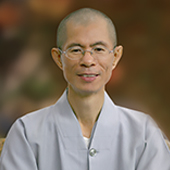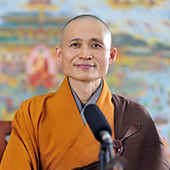What Looms Larger? The Distant Mountain or the Leaf Before Our Eyes?
A fellow practitioner, recently converted from the Sacred Path tradition to the Pure Land path, asked to become my disciple.
Knowing he deeply revered his former teacher, I asked, "What would you do if your previous master encountered you someday and strongly urged you to abandon Amitabha-recitation?"
He waved his hands dismissively. "Don't worry, Master. I wouldn't listen to him. I'd flatly refuse."
I pressed further: "What if I myself gave up reciting Amitabha’s name and took up another practice? What then?"
After a short pause, he replied earnestly, "Then I'd follow your lead, Master. Whatever practice you adopt, I'll adopt too."
I sat silent for a moment, then showed him a passage on "the hallmark of resolute faith" from the Commentary on the Contemplation Sutra by Master Shandao. It describes three trials a practitioner goes through to demonstrate his unwavering faith in the practice of Amitabha-recitation.
First, countless Bodhisattvas below the first ground, along with Arhats and Pratyekabuddhas, urge the practitioner to abandon Amitabha-recitation. Yet their faith remains unshaken.
Next, Bodhisattvas from the first to tenth grounds throughout the universe declare the practice is false and illusory. Still, no doubt arises.
Finally, emanation and reward-body Buddhas appear in radiant light, claiming that Shakyamuni Buddha never taught Amitabha-recitation. Even then the practitioner's conviction doesn't waver.
Master Shandao then concludes that only those who withstand such trials without a trace of doubt truly possess the hallmark of a committed Pure Land practitioner.
Having read this passage, my student looked perplexed, muttering, "But isn't following my teacher's practice the right thing to do? How could that be wrong?"
"It is wrong," I explained. "A Pure Land practitioner takes refuge not in any particular monastic, Dharma master, or Bodhisattva - but in Amitabha Buddha himself."
Whenever I teach this passage in class, I ask my students, "Would your faith waver under such tests?" Invariably, they respond with conviction: "Never, Master!" Yet here we are - when an unremarkable monk in this Dharma-Decline age quietly changes his practice, his followers immediately do the same without even requiring persuasion.
Alas!
A mountain stands majestic, yet from a distance appears insignificant.
A mere leaf is tiny, yet held before your eyes blocks the entire view.
The virtues of Buddhas and Bodhisattvas outshine the sun and moon, yet their greatness fails to influence our dedication to Amitabha-recitation - simply because they feel distant.
Meanwhile, we blindly follow mediocre teachers of little merit - simply because they stand right before us.
The only difference is proximity, yet the impact couldn't be more profound.
We should be cautious not of the Bodhisattvas or lineage masters written about in ancient texts, but of our neighbors down the street and the self-proclaimed spiritual teachers at our local centers.
The saints and sages in texts are just abstract concepts, but the people around us are living, breathing beings who speak into our ears.
As Master Shandao laments:
Though we are clearly shown the path to the Western Land of Bliss,
We’re led astray by others and remain trapped in samsara,
This has been happening throughout countless eons,
Not just in this lifetime have we been misguided.
(Translated by the Pure Land School Translation Team;
edited by Householder Fojin)
Guiding Principles
Faith in, and acceptance of, Amitabha’s deliverance
Single-minded recitation of Amitabha’s name
Aspiration to rebirth in Amitabha’s Pure Land
Comprehensive deliverance of all sentient beings


